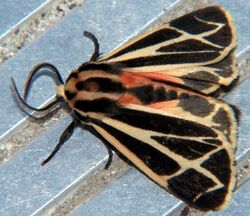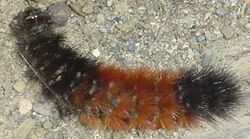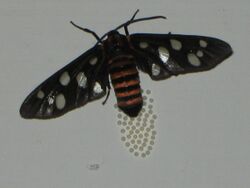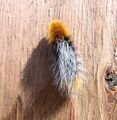Biology:Arctiinae (moth)
| Arctiinae | |
|---|---|

| |
| Harnessed tiger moth Apantesis phalerata | |
| Scientific classification | |
| Domain: | Eukaryota |
| Kingdom: | Animalia |
| Phylum: | Arthropoda |
| Class: | Insecta |
| Order: | Lepidoptera |
| Superfamily: | Noctuoidea |
| Family: | Erebidae |
| Subfamily: | Arctiinae (Leach, 1815) |
| Type species | |
| Arctia caja | |
| Diversity | |
| 1,400–1,500 genera Approximately 11,000 species | |
The Arctiinae (formerly called the family Arctiidae) are a large and diverse subfamily of moths, with around 11,000 species found all over the world, including 6,000 neotropical species.[1] This group includes the groups commonly known as tiger moths (or tigers), which usually have bright colours, footmen, which are usually much drabber, lichen moths, and wasp moths. Many species have "hairy" caterpillars that are popularly known as woolly bears or woolly worms. The scientific name of this subfamily refers to this hairiness (Gk. αρκτος = a bear). Some species within the Arctiinae have the word “tussock” in their common name due to people misidentifying them as members of the Lymantriinae based on the characteristics of the larvae.
Taxonomy
The subfamily was previously classified as the family Arctiidae of the superfamily Noctuoidea and is a monophyletic group.[2] Recent phylogenetic studies have shown that the group is most closely related to litter moths Herminiinae and the Old World Aganainae, which are subfamilies of the family Erebidae.[3] The Arctiidae as a whole have been reclassified to represent this relationship. The family was lowered to subfamily status as the Arctiinae within the Erebidae. The subfamilies and tribes of Arctiidae were lowered to tribes and subtribes, respectively, of this new Arctiinae to preserve the internal structure of the group.[4]
| Taxon rank | Former classification | Current classification |
|---|---|---|
| Superfamily | Noctuoidea | Noctuoidea |
| Family | Arctiidae | Erebidae |
| Subfamily | Arctiinae, Lithosiinae, Syntominae | Arctiinae |
| Tribe | Arctiini, Ctenuchini, Eudesmiini, Lithosiini, etc. | Arctiini, Lithosiini, Syntomini |
| Subtribe | — | Arctiina, Ctenuchina, Eudesmiina, Lithosiina, etc. |
| Genus | Many genera | Names and rank not changed |
| Species | Many species | Names and rank not changed |
| Taxa of the same background color represent the same group of species before and after its lowering of taxonomic rank, despite the change of suffixes. | ||
Tribes (former subfamilies)
Many genera are classified into the following tribes, while others remain unclassified (Incertae sedis).
Description
The most distinctive feature of the subfamily is a tymbal organ on the metathorax.[1] This organ has membranes which are vibrated to produce ultrasonic sounds. They also have thoracic tympanal organs for hearing, a trait which has a fairly broad distribution in the Lepidoptera, but the location and structure is distinctive to the subfamily. Other distinctive traits are particular setae ('hairs') on the larvae, wing venation, and a pair of glands near the ovipositor.[1] The sounds are used in mating[5] and for defense against predators.[6] Another good distinguishing character of the subfamily is presence of anal glands in females.[7]
Aposematism
Many species retain distasteful or poisonous chemicals acquired from their host plants.[8] Some species also have the ability to make their own defenses (Nishida, 2002). Common defenses include: cardiac glycosides (or cardenolides), pyrrolizidine alkaloids, pyrazines and histamines.[8] Larvae usually acquire these chemicals, and may retain them in the adult stage. But adults can acquire them, too, by regurgitating decomposing plants containing the compounds and sucking up the fluid.[8] Adults can transfer the defenses to their eggs, and males sometimes transfer them to females to help with defense of the eggs. Larval "hairs" may be stinging in some species, due to histamines their caterpillar makes.
The insects advertise these defenses with aposematic bright coloration, unusual postures, odours, or, in adults, ultrasonic vibrations. Some mimic moths that are poisonous or wasps that sting.[9] The ultrasound signals help nocturnal predators to learn to avoid the moths,[10][11] and for some species can jam bat echolocation.
Behavior and life cycle
Many of the caterpillars and adults are active during the daytime; however, most species of this taxa are night-flying. Moths are attracted by light, but there is one species, Borearctia menetriesii, that never comes to the light. Basking to accelerate digestion is common in the larval stages, and social behaviour may range from solitary to gregarious. Like most Lepidoptera, larvae produce a small silk pad before each moult, in which their prolegs are engaged.
If disturbed, woolly bear caterpillars will roll into a tight spiral or drop from their perch suspended by a strand of silk. Isabella tiger moths (Pyrrharctia isabella) overwinter in the caterpillar stage. They can survive freezing at moderate subzero temperatures by producing a cryoprotectant chemical.[12] The larvae of another species, Phragmatobia fuliginosa, may be found on snow seeking a place to pupate. Species in Arctic and temperate belts overwinter in larval stage.
Some tiger moths produce ultrasonic clicks in response to the echolocation of bats to protect themselves.
Many species are polyphagous in larva stage. Monophagous species, like the Cinnabar moth (Tyria jacobaeae) are scarce.
Although abundant, few species in this subfamily are of economic importance. Even the fall webworm, an abundant and highly polyphagous tree-feeding species that has spread from North America to Asia and Europe, does not do lasting damage to healthy hosts.
Folklore

Local folklore of the United States Northeast and the United States South hold that "woolly bears" (or "woolly worms" in the South) help humans predict the weather, similar to the groundhog. The forthcoming severity of a winter may be indicated by the amount of black on the Isabella tiger moth's caterpillar—the most familiar woolly bear in North America. More brown than black is said to mean a mild winter, while more black than brown is supposed to mean a harsh winter.[13] However, the relative width of the black band varies among instars, not according to weather.[14] The mythical qualities attributed to woolly bears in America have led to such things as the Woollybear Festival in Ohio, the Woolly Worm Festival in Beattyville, Kentucky and the Woolly Worm Festival in Banner Elk, North Carolina.
Notable species
- Pale tiger moth, Halysidota tessellaris
- Banded woolly bear or Isabella tiger moth, Pyrrharctia isabella
- Buff ermine, Spilarctia lutea
- Cinnabar moth, Tyria jacobaeae
- Common footman, Manulea lurideola
- Dogbane tiger moth or delicate cycnia, Cycnia tenera
- Fall webworm, Hyphantria cunea
- Garden tiger moth, Arctia caja
- Grote's Bertholdia, Bertholdia trigona
- Giant leopard moth, Hypercompe scribonia
- Hickory tiger moth, Lophocampa caryae
- Jersey tiger moth, Euplagia quadripunctaria
- Milkweed tiger moth, Euchaetes egle
- Scarlet tiger moth, Callimorpha dominula
- Maltese ruby tiger moth, Phragmatobia fuliginosa ssp. melitensis
- Ornate moth, Utetheisa ornatrix
- Muxta, Muxta xanthopa
Gallery
Final instar of Euchaetes egle
Apantesis arge, caterpillar
Halysidota tessellaris, cocoon
See also
- List of arctiine genera
Notes and references
- ↑ 1.0 1.1 1.2 Scoble, MJ. (1995). The Lepidoptera: Form, Function and Diversity. Second ed. Oxford University Press.
- ↑ Fibiger, Michael; Hacker, Hermann (June 29, 2005). "Systematic List of the Noctuoidea of Europe (Notodontidae, Nolidae, Arctiidae, Lymantriidae, Erebidae, Micronoctuidae, and Noctuidae)". Esperlana 11: 93–205.
- ↑ Zahiri, Reza (2011). "Molecular phylogenetics of Erebidae (Lepidoptera, Noctuoidea)". Systematic Entomology 37: 102–124. doi:10.1111/j.1365-3113.2011.00607.x.
- ↑ Lafontaine, Donald; Schmidt, Christian (19 Mar 2010). "Annotated check list of the Noctuoidea (Insecta, Lepidoptera) of North America north of Mexico". ZooKeys 40: 26. doi:10.3897/zookeys.40.414. https://zookeys.pensoft.net/articles.php?id=2182.
- ↑ Simmons, RB; Conner, WE (1996). "Ultrasonic signals in the defense and courtship of Euchaetes egle Drury and E. bolteri Stretch. (Lepidoptera: Arctiidae)". Journal of Insect Behavior 9 (6): 909–919. doi:10.1007/BF02208978.
- ↑ Fullard, JH; Simmons, JA; Sailant, PA (1994). "Jamming bat echolocation: the dogbane tiger moth Cycnia tenera times its clicks to the terminal attack calls of the big brown bat Eptesicus fuscus.". Journal of Experimental Biology 194: 285–298.
- ↑ Holloway JD. (1988). The Moths of Borneo 6: Family Arctiidae.
- ↑ 8.0 8.1 8.2 Weller, SJ; Jacobsen, NL; Conner, WE (1999). "The evolution of chemical defenses and mating systems in tiger moths (Lepidoptera: Arctiidae)". Biol J Linn Soc 68 (4): 557–578. doi:10.1111/j.1095-8312.1999.tb01188.x.
- ↑ Simmons RB, Weller SE (2002). What kind of signals do mimetic tiger moths send? A phylogenetic test of wasp mimicry systems (Lepidoptera: Arctiidae: Euchromiini). Proc Roy Soc Lond B 269: 983–990.
- ↑ Dunning, DC; Roeder, KD (1965). "Moth sounds and the insect-catching behavior of bats". Science 147 (3654): 173–174. doi:10.1126/science.147.3654.173.
- ↑ Hristov, NI; Conner, WE (2005). "Sound strategy: acoustic aposematism in the bat–tiger moth arms race". Naturwissenschaften 92 (4): 164–169. doi:10.1007/s00114-005-0611-7. PMID 15772807.
- ↑ Layne, JR; Kuharsky, DK (2000). "Triggering of cryoprotectant synthesis in the woolly bear caterpillar (Pyrrharctia isabella Lepidoptera : Arctiidae)". J Exp Zool 286 (4): 367–371. doi:10.1002/(sici)1097-010x(20000301)286:4<367::aid-jez4>3.0.co;2-f.
- ↑ [1]
- ↑ Wagner, DL. (2005). Caterpillars of Eastern North America. Princeton University Press.
Other references
- Bates, DL; Fenton, MB (1990). "Aposematism or startle? Predators learn their responses to the defenses of prey". Can J Zool 68: 49–52. doi:10.1139/z90-009.
- Dunning, DC; Krüger, M (1995). "Aposematic sounds in African moths". Biotropica 27 (2): 227–231. doi:10.2307/2388998.
- Dunning, DC; Acharya, L; Merriman, CB; Ferro, LD (1992). "Interactions between bats and arctiid moths". Can J Zool 70 (11): 2218–2223. doi:10.1139/z92-298.
- Fullard, JH; Fenton, MB; Simmons, JA (1979). "Jamming bat echolocation: the clicks of arctiid moths". Can J Zool 57 (3): 647–649. doi:10.1139/z79-076.
- Science Fridays: Moths Can Escape Bats By Jamming Sonar
Main species catalogs
- Dubatolov, VV (2010). "Tiger-moths of Eurasia (Lepidoptera, Arctiidae) (Nyctemerini by Rob de Vos & Vladimir V. Dubatolov)". Neue Entomologische Nachrichten 65: 1–106.
- Edwards, ED (1996). "Arctiidae". Monographs on Australian Lepidoptera 4 (278–286): 368–370.
- Ferguson, DC; Opler, PA (2006). "Checklist of the Arctiidae (Lepidoptera: Insecta) of the continental United States and Canada". Zootaxa 1299: 1–33.
- Goodger DT, Watson A. (1995). The Afrotropical Tiger-Moths. An illustrated catalogue, with generic diagnosis and species distribution, of the Afrotropical Arctiinae (Lepidoptera: Arctiidae). Apollo Books Aps.: Denmark, 55 pp.
- Watson, A (1971). "An illustrated Catalog of the Neotropic Arctiinae type in the United States National Museum (Lepidoptera: Arctiidae) Part 1". Smithsonian Contributions to Zoology 50: 1–361.
- Watson, A; Goodger, DT (1986). "Catalogue of the Neotropical Tiger-moths". Occasional Papers on Systematic Entomology 1: 1–71.
Phylogenetic analyses
- Da Costa, MA; Weller, SJ (2005). "Phylogeny and classification of Callimorphini (Lepidoptera: Arctiidae: Arctiinae)". Zootaxa 1025: 1–94.
- Dubatolov VV (2006) Cladogenesis of tiger-moths of the subfamily Arctiinae: development of a cladogenetic model of the tribe Callimorphini (Lepidoptera, Arctiidae) by the SYNAP method. Euroasian Entomological Journal 5(2):95–104 (in Russian).
- Dubatolov VV (2008) Construction of the phylogenetic model for the genera of the tribe Arctiini (Lepidoptera, Arctiidae) with the SYNAP method. Entomological Review 88(7):833-837. Translated from: Entomologicheskoe Obozrenie 87(3):653–658
- Dubatolov VV (2009) Development of a phylogenetic model for the tribe Micrarctiini (Lepidoptera, Arctiidae) by the SYNAP method. Entomological Review 89(3):306–313. Translated from: Zoologicheskii Zhurnal. 88(4):438–445
- Jacobson NL, Weller SJ (2002) A cladistic study of the Arctiidae (Lepidoptera) by using characters of immatures and adults. Thomas Say publications in entomology. Entomological Society of America | Lanham, Maryland, 98 pp.
Distribution analyses
- Dubatolov, VV (2008). "Analysis of Insect Distribution in the Northern Hemisphere by the Example of the Subfamily Arctiinae (Lepidoptera, Artctiidae)". Contemporary Problems of Ecology 1 (2): 183–193, 194–203.
Further reading
- William Conner (ed.). (2009). Tiger moths and woolly bears : behavior, ecology, and evolution of the Arctiidae. Oxford University Press: New York City . ISBN:978-0-19-532737-3
External links
| Wikimedia Commons has media related to Arctiinae. |
- Family Arctiidae at Lepidoptera.pro
- Belize Arctiidae Digital colour "plates"
- Jamaica Arctiidae Digital colour "plates"
- Digital images of Neotropical Arctiidae and Geometridae
- SZM Digital images
- Butterflies and Moths of North America - Apantesis nais - Tiger Moth
- on the UF / IFAS Featured Creatures Web site
- Beattyville Woolly Worm Festival 2012 Site
Wikidata ☰ Q18392591 entry












